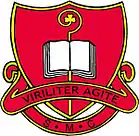St Muredach's College
St Muredach's College is an all-boys secondary school on the banks of the River Moy in Ballina, County Mayo. It was founded in 1906 to provide a Catholic education for boys in the Killala Diocese.
| St Muredach's College | |
|---|---|
 St. Muredach's College Crest | |
| Address | |

| |
Sligo Road Ballina , County Mayo Republic of Ireland | |
| Information | |
| Funding type | Department of Education and Skills |
| Motto | Viriliter Agite ('Act in a manly way') |
| Denomination | Roman Catholic |
| Patron saint(s) | St. Muredach |
| Founded | 10 September 1906 |
| Founder | Bishop of Killala |
| School number | 64510J |
| Principal | Leo Golden |
| Gender | Male |
| Age | 12 to 19 |
| Number of students | 440 |
| Classes offered | First Year to Leaving Certificate |
| Hours in school day | Monday and Tuesday 6hrs 40 mins, Wednesday to Friday 6hrs |
| Colour(s) | White and red |
| Sports | Soccer, Gaelic football, basketball, rugby, golf, athletics |
| Nickname | Muredach's |
| Website | www.stmuredachscollege.ie |
History
The development of what would become St. Muredach's College was initially proposed in 1901 the then Bishop of Killala, because there was otherwise no secondary school between Belmullet and Sligo. The school opened on 10 September 1906.
The original school building was designed by W.H. Byrne and built for a sum of £16,000. Originally housing 76 boarding students, the first floor of this building (now known as the 'old building') was used for accommodation. Some teachers and other employees also lived on the college grounds.
The school followed the British curriculum until 1924, when the Free State's Intermediate and Leaving Certificate Examinations were introduced. A new extension was opened in 1937. Numbers increased further, and in 1967, an enrolment increase occurred with the coming of free education nationally. This decision also meant that all Irish secondary schools, including St. Muredachs, had to offer technical subjects to cater for all interests and skills. Mechanical drawing, woodwork, art and other subjects were introduced. Extra classrooms were required, and a further extension was added in the late 1960s. A P.E. hall was added in the 1970s.
By the late 1980s, boarding was phased out, and a new building (incorporating a chemistry lab, woodwork room, art room and other classrooms) came into use in the early 1990s. A computer room, library and canteen were added in the late 1990s and early 2000s.
The Very Reverend Cyril Haran taught here.[1]